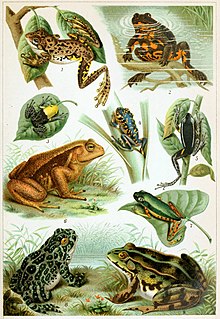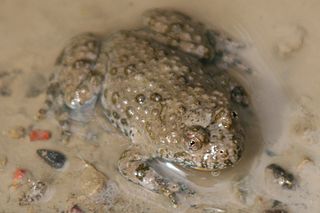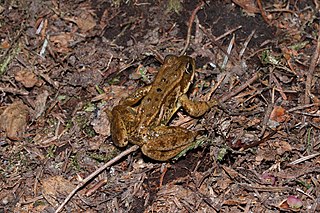Related Research Articles

A frog is any member of a diverse and largely carnivorous group of short-bodied, tailless amphibians composing the order Anura. The oldest fossil "proto-frog" appeared in the early Triassic of Madagascar, but molecular clock dating suggests their origins may extend further back to the Permian, 265 million years ago. Frogs are widely distributed, ranging from the tropics to subarctic regions, but the greatest concentration of species diversity is in tropical rainforest. There are over 6,300 recorded species, accounting for around 88% of extant amphibian species. They are also one of the five most diverse vertebrate orders. Warty frog species tend to be called toads, but the distinction between frogs and toads is informal, not from taxonomy or evolutionary history. All toads are frogs, but not all frogs are toads.

Bombinatoridae is a family of toads found in Eurasia. Species of the family have flattened bodies and some are highly toxic.

The fire-bellied toads are a group of six species of small frogs belonging to the genus Bombina.
Bombesin is a 14-amino acid peptide originally isolated from the skin of the European fire-bellied toad. It has two known homologs in mammals called neuromedin B and gastrin-releasing peptide. It stimulates gastrin release from G cells. It activates three different G-protein-coupled receptors known as BBR1, -2, and -3. It also activates these receptors in the brain. Together with cholecystokinin, it is the second major source of negative feedback signals that stop eating behaviour.

The Colorado River toad, also known as the Sonoran Desert toad, is found in northern Mexico and the southwestern United States. Its toxin, as an exudate of glands within the skin, contains 5-MeO-DMT and bufotenin.

The European fire-bellied toad is a fire-bellied toad native to mainland Europe. Other common names used for the European fire-bellied toad include ringing frog, fiery toad, fire frog, and firebelly toad.

The yellow-bellied toad belongs to the order Anura, the archaeobatrachial family Bombinatoridae, and the genus of fire-bellied toads.

The Oriental fire-bellied toad is a small semiaquatic frog species found in Korea, northeastern China, and adjacent parts of Russia. An introduced population exists near Beijing. They are commonly kept as pets in land and water vivaria. B. orientalis is also known as the 'tuti toad'.

Eccrine glands are the major sweat glands of the human body, found in virtually all skin, with the highest density in palm and soles, then on the head, but much less on the trunk and the extremities. In other mammals, they are relatively sparse, being found mainly on hairless areas such as foot pads. They reach their peak of development in humans, where they may number 200–400/cm² of skin surface. They produce a clear, odorless substance, sweat, consisting primarily of water.

Cathelicidin antimicrobial peptides (CAMP) LL-37 and FALL-39 are polypeptides that are primarily stored in the lysosomes of macrophages and polymorphonuclear leukocytes (PMNs); in humans, the CAMP gene encodes the peptide precursor CAP-18, which is cleaved into the active forms LL-37 and FALL-39.

The term skin flora refers to the microorganisms which reside on the skin, typically human skin.

The Apennine yellow-bellied toad is a species of toad in the family Bombinatoridae endemic to Italy. Its natural habitats are temperate forests, temperate grassland, swamps, freshwater marshes, intermittent freshwater marshes, arable land, pastureland, ponds, open excavations, irrigated land, and seasonally flooded agricultural land. It is threatened by habitat loss.

Amolops ricketti is a species of frog in the family Ranidae that is found in southern and eastern China and northern and central montane Vietnam.

The Cascades frog is a species of frog in the family Ranidae found in the Pacific Northwest, mainly in the Cascade Range and Olympic Mountains.

Graham's frog, also known as the diskless-fingered odorous frog, is a species of frog in the family Ranidae. It is found in China and Vietnam. Presumably it is also found in Myanmar in areas adjacent to its Chinese distribution area.

Beta-defensin 2 (BD-2) also known as skin-antimicrobial peptide 1 (SAP1) is a peptide that in humans is encoded by the DEFB4 gene.

Arenobufagin is a cardiotoxic bufanolide steroid secreted by the Argentine toad Bufo arenarum. It has effects similar to digitalis, blocking the Na+/K+ pump in heart tissue.
Esculentin-2CHa is an antimicrobial peptide located outside the epithelial cell's membrane of the skin of many species of amphibians, such as Rana chiricahuensis. This peptide has recently become more important due to its defense response function and its possible application in the treatment of various human pathologies, that range from type 2 diabetes to bacterial and fungi infections. Esculentin-2CHa is a peptide that belongs to the Esculentin-2 family, which is known for its broad-spectrum of antimicrobial activity and its low cytotoxicity to human erythrocytes. However, not much is known about its structures and their relation to the functions these peptides carry out.

A kambo cleanse, also known as a kambo circle or kambo ceremony, kambo, vacina-do-sapo, or sapo, is a purge using skin secretions of the kambô, a species of frog. The effects on humans usually include nausea, vomiting and diarrhoea; multiple deaths have been associated with its use. Kambo, which originated as a folk medicine practice among indigenous peoples of the Amazon, is also administered as an alternative medicine treatment in the West, often as a pseudoscientific cleanse or detox. The ceremony involves burning an arm or leg and applying the kambo secretion directly to the burn. Proponents claim that kambo helps with a number of illnesses or injuries, but there is no scientific evidence that it is an effective treatment of any kind.
Grammistins are peptide toxins synthesised by glands in the skin of soapfishes of the tribes Grammistini and Diploprionini which are both classified within the grouper subfamily Epinephelinae, a part of the family Serranidae. Grammistin has a hemolytic and ichthyotoxic action. The grammistins have secondary structures and biological effects comparable to other classes of peptide toxins, melittin from the bee stings and pardaxins which are secreted in the skin of two sole species. A similar toxin has been found to be secreted in the skin of some clingfishes.